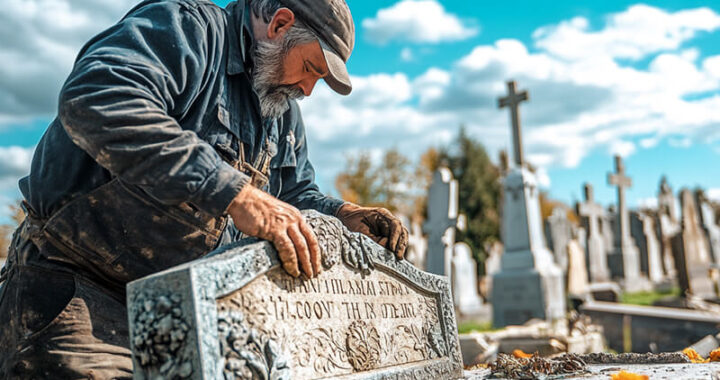Changing Headstone Inscriptions
Changing a headstone inscription involves complex decisions and processes. The ability to make changes depends on cemetery rules, stone type, and legal considerations. Understanding these factors helps families make informed choices about modifying grave markers.
Legal permission comes first in the modification process. The person who owns the burial rights must approve any changes. This owner might be different from the person who paid for the stone. Cemetery offices keep records of burial right ownership.
Cemetery regulations control inscription changes. Each cemetery sets its own rules about marker modifications. Some ban changes to existing stones. Others require approval for any alterations. These rules protect the cemetery’s appearance and maintenance standards.
The stone’s material affects modification options. Granite allows for new engraving or text additions. Marble poses more challenges due to its soft nature. Bronze markers need specialized techniques. Each material requires different tools and methods.
Professional stone workers must perform the changes. DIY attempts can damage stones beyond repair. Licensed memorial companies have the right tools and skills. They know how to preserve the stone’s integrity while making changes.
The age of the headstone matters for modifications. Older stones may be too fragile for changes. Weather damage can make surfaces unstable. Antique markers might have historic value that changes would destroy.
Cost varies based on the type of change needed. Adding dates to existing text costs less than full modifications. New artwork or designs increase the price. Location changes might require a new stone base. Each element adds to the total expense.
Some changes require removing the stone from the cemetery. Work happens at the memorial company’s shop. This process adds transportation costs. It also takes time while the stone is away from the grave site.
Weather conditions affect when changes can occur. Cold temperatures make stone more brittle. Rain prevents proper adhesion of new materials. Seasonal timing impacts project schedules and costs.
Insurance requirements protect against damage. Memorial companies need proper coverage. Cemeteries may demand proof of insurance. These policies safeguard all parties during modifications.
Alternative solutions exist for difficult changes. Small plaques can attach to existing stones. New markers can stand near original ones. These options preserve historic stones while adding information.
Family discussions should precede any changes. All interested parties need input on modifications. Arguments about changes can damage family relationships. Clear communication prevents future conflicts.
Documentation helps track monument changes. Before and after photos preserve the stone’s history. Written records show what changes occurred. This information helps future family researchers.
The stone’s foundation needs inspection before changes. Weight changes can affect stability. New text might require rebalancing the stone. Foundation repairs add to project costs.
Modern technology offers new modification methods. Laser etching works on some materials. Digital design shows preview images. These tools help families visualize changes before commitment.
Original stone warranties may affect changes. Some warranties become void after modifications. New work needs separate guarantee coverage. Check warranty terms before proceeding.
Matching original fonts challenges stone workers. Old style typefaces may not exist now. Hand carving might need to copy existing text. Font differences show which text changed.
Space limitations restrict possible changes. Original designs leave varying amounts of empty space. Text size affects how much can fit. Stone workers need proper spacing for clear reading.
Temporary solutions work for some situations. Removable plaques mark recent deaths. Metal plates cover incorrect information. These options buy time for permanent decisions.
The full process takes time to complete. Permission steps need official responses. Weather delays slow work progress. Families should plan several weeks for changes.
Professional advice helps prevent mistakes. Memorial companies know what works. Cemetery staff understand local rules. Their experience guides families through the process. This guidance leads to successful headstone modifications that honor the deceased.

